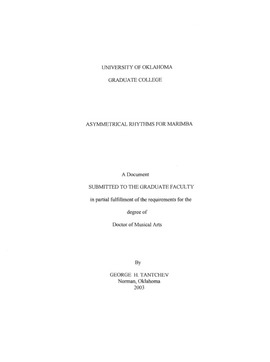| dc.contributor.advisor | Wakefield, William, | en_US |
| dc.contributor.author | Tantchev, George Hristov. | en_US |
| dc.date.accessioned | 2013-08-16T12:19:15Z | |
| dc.date.available | 2013-08-16T12:19:15Z | |
| dc.date.issued | 2003 | en_US |
| dc.identifier.uri | https://hdl.handle.net/11244/668 | |
| dc.description.abstract | The exploration of the potential of the marimba as a solo instrument in recent decades fostered the creation of an unprecedented volume of works written specifically for the instrument. Modern composers constantly challenge marimbists technically and musically by exploring the possibilities of two, four and even six mallet technique. Often these new pieces present yet another challenge for the marimbist in the form of asymmetric rhythmic combinations. Such rhythms are found in various levels of marimba compositions in works by Keiko Abe, Richard Gipson, Toshimitsu Tanaka, Andrew Thomas, Gordon Stout, Paul Smadbeck, Dobri Paliev, Tsenko Minkin and other prominent marimba composers. These challenging rhythms are present even in the very first pieces marimbists typically play. For this reason it is important for marimbists to develop a feel for the most often used asymmetrical rhythms. Students often have to perform pieces containing asymmetrical rhythms and it is important to analyze short and long beats to determine which beats should be accented more than others. | en_US |
| dc.description.abstract | According to Bela Bartok, the elongation of the note value is a translation of a dynamic stress. This requires accenting the longer beat(s) in a given asymmetrical rhythm stronger that the duple meter(s). In order to achieve an awareness for the pulsation of strong and weak beats, Bartok suggests a series of exercises to be presented to students from the very beginning of their musical studies. Following his pedagogical suggestions the present study offers clapping, drumming and oral exercises for the most commonly applied asymmetrical rhythms in the marimba repertoire, such as 5/8 (articulated 2 + 3 and 3 + 2), 7/8 (articulated 2 + 2 + 3 and 3 + 2 + 2), 9/8 (articulated 2 + 2 + 2 + 3), and 11/8 (articulated 2 + 2 + 3 + 2 + 2). Practicing these exercises will assist marimbists in internalizing the natural flow of each rhythm. | en_US |
| dc.format.extent | vii, 57 leaves : | en_US |
| dc.subject | Education, Music. | en_US |
| dc.subject | Musical meter and rhythm. | en_US |
| dc.subject | Marimba Instruction and study. | en_US |
| dc.subject | Music. | en_US |
| dc.title | Asymmetrical rhythms for marimba. | en_US |
| dc.type | Thesis | en_US |
| dc.thesis.degree | D.M.A. | en_US |
| dc.thesis.degreeDiscipline | School of Music | en_US |
| dc.note | Adviser: William Wakefield. | en_US |
| dc.note | Source: Dissertation Abstracts International, Volume: 64-10, Section: A, page: 3532. | en_US |
| ou.identifier | (UMI)AAI3109063 | en_US |
| ou.group | Weitzenhoffer Family College of Fine Arts::School of Music | |
